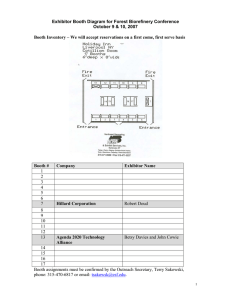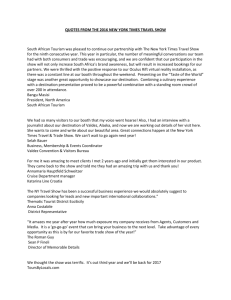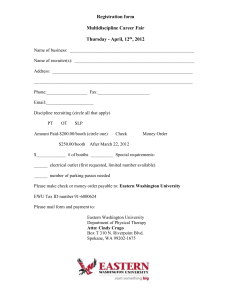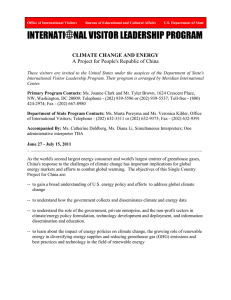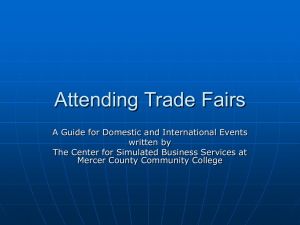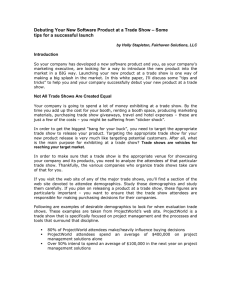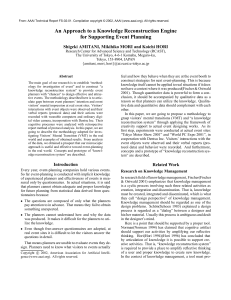Customer Service is IN the Booth!
advertisement
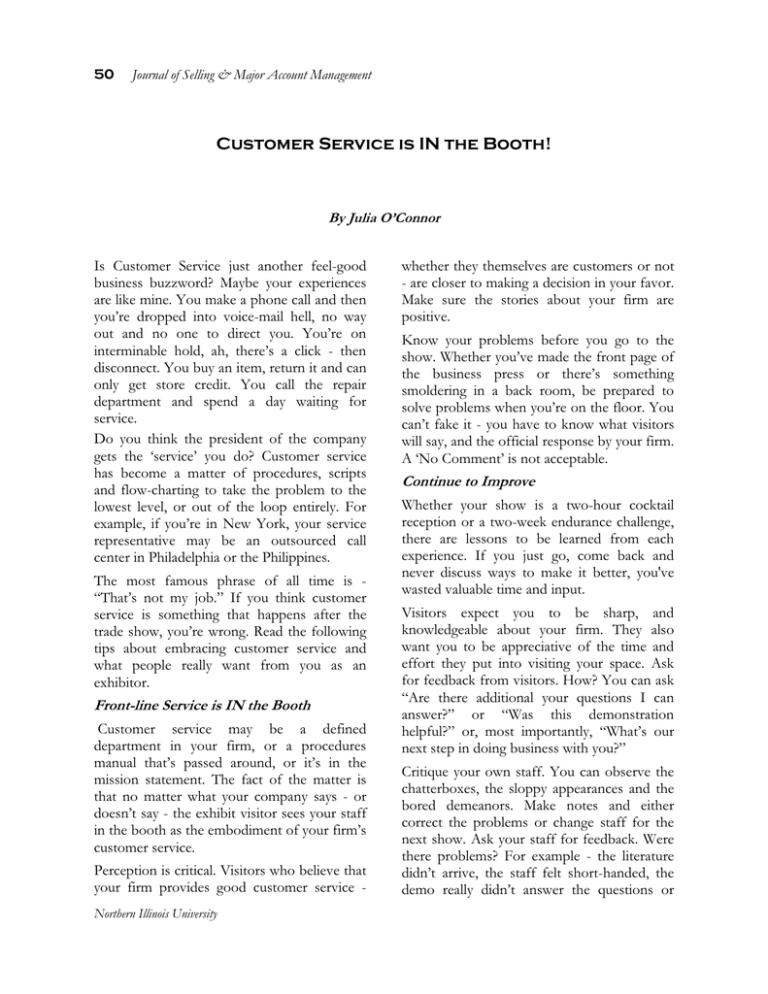
50 Journal of Selling & Major Account Management Customer Service is IN the Booth! By Julia O’Connor Is Customer Service just another feel-good business buzzword? Maybe your experiences are like mine. You make a phone call and then you’re dropped into voice-mail hell, no way out and no one to direct you. You’re on interminable hold, ah, there’s a click - then disconnect. You buy an item, return it and can only get store credit. You call the repair department and spend a day waiting for service. Do you think the president of the company gets the ‘service’ you do? Customer service has become a matter of procedures, scripts and flow-charting to take the problem to the lowest level, or out of the loop entirely. For example, if you’re in New York, your service representative may be an outsourced call center in Philadelphia or the Philippines. The most famous phrase of all time is “That’s not my job.” If you think customer service is something that happens after the trade show, you’re wrong. Read the following tips about embracing customer service and what people really want from you as an exhibitor. Front-line Service is IN the Booth Customer service may be a defined department in your firm, or a procedures manual that’s passed around, or it’s in the mission statement. The fact of the matter is that no matter what your company says - or doesn’t say - the exhibit visitor sees your staff in the booth as the embodiment of your firm’s customer service. Perception is critical. Visitors who believe that your firm provides good customer service Northern Illinois University whether they themselves are customers or not - are closer to making a decision in your favor. Make sure the stories about your firm are positive. Know your problems before you go to the show. Whether you’ve made the front page of the business press or there’s something smoldering in a back room, be prepared to solve problems when you’re on the floor. You can’t fake it - you have to know what visitors will say, and the official response by your firm. A ‘No Comment’ is not acceptable. Continue to Improve Whether your show is a two-hour cocktail reception or a two-week endurance challenge, there are lessons to be learned from each experience. If you just go, come back and never discuss ways to make it better, you've wasted valuable time and input. Visitors expect you to be sharp, and knowledgeable about your firm. They also want you to be appreciative of the time and effort they put into visiting your space. Ask for feedback from visitors. How? You can ask “Are there additional your questions I can answer?” or “Was this demonstration helpful?” or, most importantly, “What’s our next step in doing business with you?” Critique your own staff. You can observe the chatterboxes, the sloppy appearances and the bored demeanors. Make notes and either correct the problems or change staff for the next show. Ask your staff for feedback. Were there problems? For example - the literature didn’t arrive, the staff felt short-handed, the demo really didn’t answer the questions or Application Article there were technical glitches. Perhaps there were some personality clashes, too many inexperienced staffers, too many engineers or, best of all, the balance was just right and they’ll all like to do it again. Really Listen Here’s the problem - you’re in the booth. You know your product and you want to tell everybody absolutely everything about it. Your enthusiasm is wonderful but you overwhelm the visitor. They feel blasted with words. Your exhibit, the graphics, the demonstrations, and the brochures should answer the general questions about your firm. Remember though that time is short and people may read nothing that’s in your space. They may be totally unfamiliar with your firm and its products, and they’ll ask “So, what do you do?” Be ready with a very simple explanation, and be prepared to say it 100 times a day. Before the show, review your normal sales process and find ways to pare it down. Understand the words and phrases that are “hot words” the prospect will use when there’s interest. Listen carefully for these key words and prepare to take action. Also listen for new concerns about your firm, products, or of the industry in general. Who’s in Charge? Customer service problems are leadership problems and Customer Service starts at the top. When the President and management of your company haven’t experienced the hoops that the Average Joe has to jump through to get information, return a product or lodge a complaint with your company, then they have distanced themselves as a Company from the actuality of a Client. Before you go to the show, call your company’s general customer service line with a routine problem. Keep track of how long it takes and how many people you speak with before you connect with a person who can Fall 2008 51 solve your problem. Do not use the web site, assume you don’t have a computer. For real frustration, assume you don’t have a push-button phone. Anything that requires more than two minutes on hold and two transfers will lose you customers. No matter the size of your staff, be certain that each show has a general manager and each shift has a manager with authority to solve problems on the spot. Be certain everyone knows the pecking order before you step on the show floor. Hold everyone accountable for what happens on the floor. While each person may have responsibility for a special component of the show, it must be considered a Team Effort. Visitors expect your firm to speak with one voice, for everyone in the booth to be knowledgeable, polite and looking forward to doing business with them. Celebrate success. You’ll know when the show was good. There’s a feeling beyond the number of leads gathered or business booked. You’ll feel that you contributed to the effort of your firm, you’ll be satisfied with your team’s performance - well, you’ll just feel good. Match Personalities Each show has a personality unto itself. It may be heavily technical or very arty. Each industry has its own vocabulary, rhythm and standards. If you don’t understand the relationships or nuances of the show to the buying patterns of the industry, you won’t be very happy. Don’t assume that the audience equals the name of the show. For example -there are technical shows which include technical staff who are influencers and non-technical purchasing staff who make the actual purchase. The company president may be an engineer but not have the final say on accounting software. If you have the opportunity to match personality to the buying audience, you will be Vol. 8, No. 4 52 Journal of Selling & Major Account Management more successful. It requires skill to place staff which are both detail-oriented to talk with the detail-seekers, and extrovert-big-picture people who can communicate with those who want a “ballpark” quote or can answer the “what if...” questions. Visitors believe that how you treat them at the show is how they will be treated if they become a client of your firm. This is absolutely the best time to put your Customer Service Extraordinaire effort into your time in the booth. Northern Illinois University
